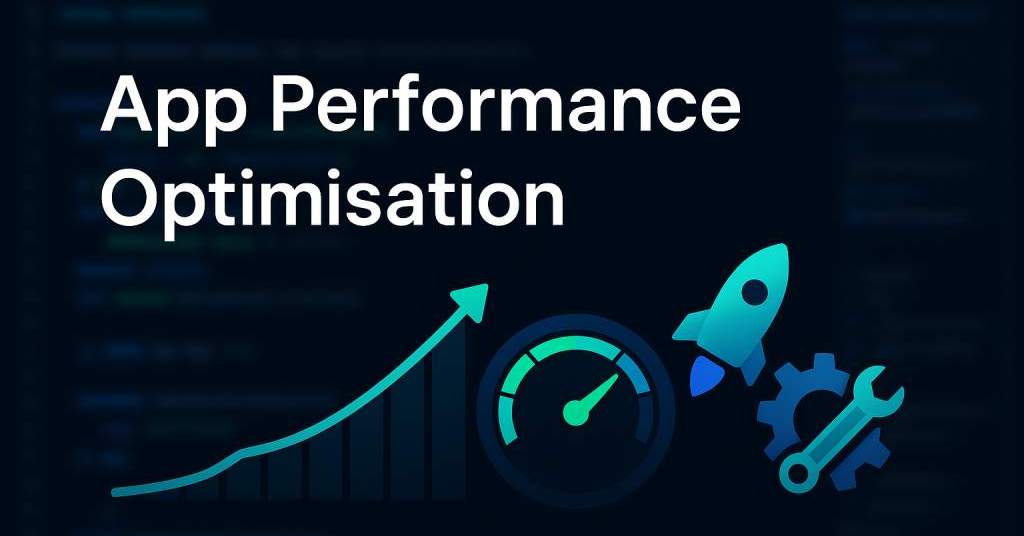
App Performance Optimisation
Nobody likes a slow, laggy app.
Users expect smooth, fast, and responsive experiences.
If your app takes too long to load, crashes frequently, or drains too much battery, people will abandon it.
Performance is directly linked to user retention, engagement, and revenue. Even a one-second delay can lead to a drop in conversions and uninstall rates.
This guide will walk you through mobile app performance optimization—why it matters, key metrics to track, common issues, and strategies to keep your app running at its best.
Let’s get started!
What is Mobile App Performance Optimization?
Mobile app performance optimization is all about making your app faster, smoother, and more efficient.
It ensures that users don’t face delays, crashes, or excessive battery drain.
The goal?
Deliver a seamless experience across all devices and network conditions.
Why It Matters?
- Better User Experience – No one likes a slow app.
- Higher Retention – Faster apps keep users engaged.
- Improved App Store Rankings – Performance impacts ratings and reviews.
- Lower Uninstall Rates – Users delete laggy apps within seconds.
Optimizing performance isn’t a one-time task—it’s an ongoing process.
The next section covers the key metrics you need to track.
Key Mobile App Performance Metrics to Track
Tracking the right metrics helps you identify bottlenecks and optimize performance before users experience issues.
Here are the essential performance metrics you should monitor:
|
Metric |
Description |
Ideal Benchmark |
|
App Startup Time |
Time taken for the app to fully load. |
Under 2 seconds |
|
Frame Rate |
Smoothness of animations & UI transitions. |
60 FPS (frames per second) |
|
Memory Usage |
Amount of RAM the app consumes. |
Minimal & optimized usage |
|
Battery Consumption |
Power usage while the app is running. |
Should not drain excessively |
|
Network Efficiency |
Time taken for API responses & data loading. |
Low latency & optimized requests |
|
Crash Rate |
Frequency of unexpected app crashes. |
Crash-free rate: 99.9% |
|
App Responsiveness |
Speed of user interactions and feedback. |
Instant, under 100ms delay |
Monitoring these metrics ensures your app delivers a fast, stable, and efficient experience.
Next, let’s explore what causes poor app performance in the first place.
Causes of Poor Mobile App Performance
Before you fix performance issues, you need to understand what’s slowing your app down.
Here are the most common culprits:
Inefficient Code & Memory Leaks
- Poorly written code leads to slow execution and crashes.
- Memory leaks cause excessive RAM usage, leading to app freezes.
Slow Database Queries
- Unoptimized database queries slow down response times.
- Large datasets without proper indexing affect performance.
Excessive API Calls & Network Latency
- Too many API requests increase server load and response time.
- Uncompressed data slows down loading speeds.
Large Media Files & Unoptimized Assets
- High-resolution images and videos bloat the app size.
- Not using lazy loading causes slow UI rendering.
Device Fragmentation & OS Compatibility Issues
- Apps behave differently across various screen sizes, OS versions, and hardware specs.
- Failing to test on multiple devices leads to inconsistent performance.
A poorly optimized app drives users away. The next section covers strategies to keep your app running at peak performance.
Strategies for Mobile App Performance Optimization
Your app’s performance can make or break the user experience.
A slow, laggy app?
Users will uninstall it in seconds.
Optimizing your app isn’t just about fixing bugs.
It’s about making it faster, more efficient, and seamless across all devices and network conditions.
Here’s how you can achieve that:
a) Frontend Optimization
Reduce App Startup Time
Nobody likes to wait.
If your app takes too long to launch, users will drop off.
To speed up the startup time, only load what’s necessary.
Avoid initializing non-essential features immediately.
Instead, use lazy loading, where secondary components load in the background after the main interface appears.
Animations also impact speed. Keep transitions smooth and lightweight.
If animations are causing delays, consider reducing the complexity or using hardware acceleration for better rendering.
Images and videos can also slow down the UI.
Use compressed assets like WebP images or SVGs for icons instead of large PNGs.
Minimize the number of HTTP requests by bundling resources efficiently.
b) Backend Optimization
Optimize Data Storage & Caching
Every time your app fetches data from a server, it takes time.
If users repeatedly access the same content, caching is your best friend.
Store frequently accessed data locally using caching mechanisms like Redis, Memcached, or IndexedDB for web apps.
This reduces database calls and speeds up response times.
For static data, such as dropdown lists or configurations, avoid making server requests each time.
Load them once and store them locally.
Minimize API Response Time
Slow APIs can be a bottleneck.
If your app relies on external data, optimize API calls to reduce load times.
- Avoid unnecessary API requests. Instead of calling data on every interaction, fetch in batches or use a background sync process.
- Compress API responses using Gzip or Brotli to reduce payload size.
- Optimize database queries with indexing and pagination to prevent fetching unnecessary data.
A well-optimized backend ensures that data loads quickly without frustrating delays.
c) Network Optimization
Reduce Network Load & API Calls
Not all users have high-speed internet.
Your app needs to work smoothly, even on slower connections.
Instead of making multiple small API calls, combine requests into a single batch to reduce network traffic.
If your app requires frequent real-time updates, consider using WebSockets instead of continuous polling.
For images and other static assets, use a Content Delivery Network (CDN).
A CDN caches content on multiple servers worldwide, reducing the distance data needs to travel.
This speeds up loading times, especially for global users.
Compressing data before sending it over the network is another game-changer.
Use efficient formats like JSON instead of XML, and apply minification techniques to scripts and stylesheets.
d) Memory & Battery Optimization
Fix Memory Leaks & Optimize Resource Usage
Apps that consume too much memory tend to crash, freeze, or slow down the entire device.
That’s a one-way ticket to bad reviews.
Memory leaks occur when an app holds onto unused data instead of releasing it.
Use profiling tools like Xcode Instruments (iOS) or Android Profiler to detect and fix leaks early.
Avoid storing large amounts of temporary data in memory.
Instead, use efficient garbage collection to free up unused resources.
Reduce Battery Drain
A battery-hungry app won’t last long on a user’s device.
The biggest culprits?
Frequent background tasks, high GPS usage, and continuous network requests.
- Reduce background processes that constantly consume power.
- Optimize location tracking by using geofencing or lower-frequency updates instead of real-time tracking.
- Batch network requests rather than making them one at a time.
Battery-efficient apps not only run better but also improve user retention.
e) Database Optimization
Improve Query Speed & Data Retrieval
A slow database means a slow app.
Optimize queries by using proper indexing so that searches don’t scan the entire dataset.
Implement pagination when dealing with large data sets instead of loading everything at once.
If your app requires real-time data updates, consider Firebase Firestore or WebSockets, which offer faster sync capabilities than traditional HTTP polling.
For mobile apps, SQLite is a great choice for storing local data efficiently.
Keeping things lightweight ensures a smoother experience.
f) Security & Performance Balance
Ensure Security Without Slowing Down Your App
Security is non-negotiable, but heavy encryption or complex authentication processes can slow down performance.
To strike a balance:
- Use lightweight encryption algorithms that don’t overload processing power.
- Implement JWT (JSON Web Tokens) for secure yet fast authentication.
- Reduce excessive security checks unless absolutely necessary.
By optimizing security processes, your app stays both fast and protected.
A well-optimized app is fast, efficient, and power-friendly.
Next, let’s explore how to test your app’s performance to ensure everything runs smoothly.
Mobile App Testing for Performance
Optimizing performance isn’t enough—you need to test it rigorously to ensure your app runs smoothly under all conditions.
Performance testing helps you identify bottlenecks, crashes, slowdowns, and memory leaks before they affect users.
Here’s how to test your app effectively:
Load Testing
Apps often work fine with a few users but crash when traffic increases.
Load testing checks how your app behaves under high user demand. It helps determine:
- The maximum number of users your app can handle.
- At what point performance starts to degrade.
- If there are server bottlenecks or database slowdowns.
Tools like Apache JMeter, LoadRunner, and Gatling help simulate real-world usage to ensure your app stays fast even with heavy traffic.
Stress Testing
This is about pushing your app to its limits.
Stress testing checks how your app performs under extreme conditions—like heavy API requests, sudden traffic spikes, or resource exhaustion.
It helps uncover:
- Crash points when memory or CPU usage spikes.
- Data loss issues when the app is overloaded.
- How quickly the app recovers after failures.
By testing under extreme conditions, you ensure your app can handle unexpected situations without breaking down.
Real-Device Testing vs. Emulator Testing
Testing on an emulator is fast and convenient, but it doesn’t replicate real-world performance.
- Emulators help during early development but don’t consider factors like network latency, battery drain, or hardware differences.
- Real-device testing is a must to ensure smooth performance across different screen sizes, OS versions, and processors.
Using a cloud-based testing service like Sauce Labs, BrowserStack, or Firebase Test Lab allows testing on multiple real devices without physical hardware.
Automated vs. Manual Testing
- Automated testing speeds up performance evaluation using scripts. It’s great for load, stress, and regression testing.
- Manual testing is still essential for identifying UI/UX issues, laggy transitions, and unoptimized animations that automated tools might miss.
The best approach? Combine both for maximum efficiency.
Key Performance Testing Tools
Here are some of the best tools for tracking app performance:
|
Tool |
Best For |
|
Firebase Performance Monitoring |
Real-time app performance insights |
|
New Relic |
Backend & API monitoring |
|
AppDynamics |
Crash analysis & slow response detection |
|
Apache JMeter |
Load & stress testing |
|
TestFairy |
Real-user session monitoring |
Testing is not a one-time process. Regular performance checks help keep your app fast, stable, and efficient over time.
Next, let’s explore the best tools for monitoring and improving app performance.
Mobile App Performance Optimization Tools
Having the right tools can make or break your optimization efforts.
These tools help you track performance metrics, detect slowdowns, and fix bottlenecks before they affect users.
Here’s a breakdown of the best tools for monitoring and improving app performance:
Real-Time Performance Monitoring Tools
These tools track app performance while users interact with it, helping you catch problems as they happen.
|
Tool |
Key Features |
|
Firebase Performance Monitoring |
Monitors startup time, network latency, and UI responsiveness. |
|
New Relic |
Provides deep insights into API performance and backend slowdowns. |
|
AppDynamics |
Detects performance issues in real-time and offers crash analytics. |
These tools give you live data, so you can act before issues escalate.
Load & Stress Testing Tools
Want to see how your app holds up under heavy traffic and high user demand?
These tools simulate real-world conditions:
|
Tool |
Best For |
|
Apache JMeter |
Simulates thousands of users to test app scalability. |
|
LoadRunner |
Identifies how much traffic your app can handle. |
|
Gatling |
Helps optimize server response times under stress. |
Using these tools, you can identify bottlenecks before users experience them.
Crash & Bug Tracking Tools
Bugs and crashes can ruin user experience and lead to uninstalls.
|
Tool |
Key Benefits |
|
TestFairy |
Monitors app usage and reports crashes with detailed logs. |
|
BugSnag |
Detects and alerts you about app crashes instantly. |
|
Instabug |
Captures user feedback and reports performance issues. |
By tracking crashes early, you can fix problems before they impact retention.
Network Performance Tools
Slow API responses can frustrate users and slow down the app.
These tools help you optimize API calls and reduce latency:
|
Tool |
Best For |
|
Charles Proxy |
Debugs network traffic and API calls. |
|
Wireshark |
Analyzes data flow and identifies slowdowns. |
|
Postman |
Helps optimize API requests and responses. |
Using these tools ensures that your app loads fast, even on slow networks.
A slow or buggy app will lose users fast.
Monitoring performance regularly keeps your app stable, responsive, and efficient.
Next, let’s look at emerging trends in mobile app performance optimization to stay ahead of the game.
Future Trends in Mobile App Performance Optimization
App performance is constantly evolving.
What worked last year might not be enough today.
With faster devices, new frameworks, and changing user expectations, developers must stay ahead of the curve.
Here are the biggest trends shaping mobile app performance optimization:
AI-Driven Performance Optimization
Artificial Intelligence is making app optimization smarter and faster.
AI-based tools can:
- Predict and fix crashes before they happen.
- Adjust app resource allocation dynamically based on usage patterns.
- Optimize battery consumption by analyzing background processes.
As AI improves, apps will become more self-optimizing, reducing manual intervention.
Edge Computing for Reduced Latency
Traditional cloud computing sends all data to a central server.
But that slows things down—especially for real-time apps.
Edge computing changes that.
It processes data closer to the user, reducing server response times and improving app speed.
This is especially useful for:
- IoT apps that rely on real-time data.
- Gaming apps that need ultra-low latency.
- Streaming services that load high-quality content faster.
With 5G expansion, edge computing will play a key role in app optimization.
Progressive Web Apps (PWAs) & Hybrid Optimization
PWAs are becoming a serious competitor to native apps.
These web-based apps:
- Load faster than traditional mobile apps.
- Work offline by caching important data.
- Use fewer device resources, improving battery life.
Hybrid frameworks like Flutter & React Native are also optimizing performance better than ever, bridging the gap between native and cross-platform apps.
On-Device AI Processing
AI-powered features often rely on cloud processing, but that can be slow.
Now, with on-device AI chips, mobile apps can process data locally, reducing:
- Network dependency for AI-based tasks.
- Response time for voice commands, image recognition, and real-time recommendations.
Expect faster, more efficient AI-driven apps in the near future.
Adaptive UX for Performance Scaling
Not all users have the latest flagship phones.
Apps are now adapting their UI and features based on device capability to prevent performance issues.
For example:
- Low-end devices get a lite version with optimized graphics and fewer background tasks.
- High-end devices enjoy full-featured versions with advanced animations.
This ensures a smooth experience for every user, regardless of hardware limitations.
Users expect instant, seamless performance. Slow apps won’t survive.
Staying ahead of these trends ensures your app remains fast, efficient, and competitive in the ever-changing mobile landscape.
Next, let’s discuss common challenges in app performance optimization—and how to solve them.
Challenges & Solutions in Mobile App Performance Optimization
Optimizing an app for speed and efficiency isn’t always easy.
Performance issues can pop up unexpectedly, making it difficult to maintain a smooth user experience.
Here are some common challenges developers face—and how to overcome them.
Challenge 1: Slow App Load Time
Users expect apps to open within 2 seconds.
If your app takes longer, expect high bounce rates.
Solution:
- Implement lazy loading to load essential components first.
- Optimize startup processes by reducing heavy initializations.
- Minimize third-party SDKs that slow down app launch.
Challenge 2: High Battery Consumption
A power-hungry app is a dealbreaker.
Users will uninstall if your app drains too much battery.
Solution:
- Reduce background processes and unnecessary wake-ups.
- Optimize GPS and location services by using geofencing instead of real-time tracking.
- Lower CPU usage by processing data in smaller chunks.
Challenge 3: Network Latency & Slow API Calls
A slow internet connection should not mean a terrible user experience.
Solution:
- Use offline caching to store frequently accessed data.
- Compress API responses using Gzip or Brotli.
- Implement content delivery networks (CDN) for faster data transfer.
Challenge 4: App Crashes & Memory Leaks
Nothing kills retention faster than random crashes.
Solution:
- Use profiling tools to detect memory leaks early.
- Free up unused objects and manage memory allocation properly.
- Regularly run stress tests to ensure stability under heavy load.
Challenge 5: UI Lag & Slow Rendering
If animations and scrolling feel sluggish, users won’t stick around.
Solution:
- Keep UI updates on the main thread while offloading heavy tasks to the background thread.
- Optimize image rendering by using compressed formats like WebP.
- Reduce re-rendering by optimizing state management.
Challenge 6: Device Fragmentation
Your app must perform well across different screen sizes, OS versions, and hardware specifications.
Solution:
- Test on real devices instead of relying only on emulators.
- Use responsive UI frameworks to adapt to different screens.
- Optimize graphics and animations for low-end and high-end devices.
Challenge 7: Unstable Third-Party Integrations
Third-party SDKs (payment gateways, analytics tools, etc.) can introduce lag and crashes.
Solution:
- Regularly update third-party dependencies to their latest stable versions.
- Remove unnecessary SDKs that add bloat.
- Use asynchronous processing for non-critical third-party operations.
Performance issues can lead to negative reviews, higher uninstall rates, and lower engagement.
By addressing these challenges proactively, you can keep your app fast, stable, and user-friendly.
Next, let’s discuss how to monetize your app while maintaining optimal performance.
Monetization Strategies Without Compromising Performance
Earning revenue from your app is important, but poor monetization choices can slow down performance and drive users away.
Ads that cause lag, heavy in-app purchases, or poorly optimized payment gateways can ruin the user experience.
Here’s how to monetize your app effectively without affecting speed and usability.
1. Lightweight & Non-Intrusive Ads
Ads are a common revenue model, but they can slow down app performance if not handled correctly.
What to avoid?
- Auto-playing video ads that increase load time.
- Heavy third-party ad SDKs that consume memory and battery.
- Full-screen interstitial ads that disrupt user experience.
Best practices:
- Use lightweight ad formats like native ads that blend into the UI.
- Implement lazy loading for ads to avoid blocking the main content.
- Cache ad content in advance to prevent delays in display.
2. Efficient In-App Purchases & Subscriptions
A clunky payment experience can frustrate users and lead to abandoned purchases.
Optimization strategies:
- Use a fast and secure payment gateway to avoid slow processing times.
- Store purchase history locally to reduce unnecessary API calls.
- Implement one-tap purchases for a smoother checkout experience.
A fast and frictionless payment process keeps conversion rates high.
3. Freemium Model Without Heavy Restrictions
Freemium apps offer free basic features while charging for premium ones.
However, locking too many features behind a paywall can annoy users.
How to optimize?
- Keep free features useful enough to retain users while showcasing premium benefits.
- Avoid forcing users to reload the app after upgrading—apply changes instantly.
- Optimize server-side validation to ensure subscriptions are processed quickly.
4. Reward-Based Monetization for Better Engagement
Instead of slowing the app with ads, let users earn rewards for engagement.
Examples:
- Offer in-app currency for watching short, skippable ads.
- Allow users to unlock premium features by completing challenges.
- Implement referral bonuses to encourage app sharing.
This model increases retention without degrading performance.
5. Optimized Affiliate & E-Commerce Integrations
Affiliate links and in-app shopping features can slow down an app if not optimized properly.
Performance-friendly solutions:
- Use deferred loading to fetch e-commerce or affiliate content only when needed.
- Optimize image loading for product listings to prevent UI lag.
- Implement secure but lightweight APIs for seamless checkout experiences.
Smooth transactions improve user trust and increase revenue potential.
Monetization should enhance, not harm the user experience.
A well-optimized revenue model ensures your app remains fast, smooth, and profitable.
Next, let’s wrap things up with a final conclusion on why performance optimization is an ongoing process.
TEAM4SOLUTION – Your Partner in High-Performance App Development
At TEAM4SOLUTION , we don’t just build apps—we craft seamless digital experiences.
A slow or laggy app can cost you users, revenue, and reputation.
That’s why our team focuses on performance-driven development, ensuring your app runs smoothly across all devices.
From optimized coding and efficient backend architecture to real-time performance monitoring, we make sure your app is fast, responsive, and scalable.
Whether you're launching a new app or improving an existing one, we’ve got you covered.
Looking for an app development company that prioritizes speed and efficiency?
Let’s build something exceptional together!
Conclusion
Optimizing mobile app performance isn’t a one-time task—it’s an ongoing process.
A slow, laggy, or battery-draining app will push users away, no matter how great the features are.
On the other hand, a fast, efficient, and well-optimized app keeps users engaged, improves retention, and boosts revenue.
Throughout this guide, we covered:
✔️ Key performance metrics that impact speed and efficiency.
✔️ Common issues that slow apps down.
✔️ Strategies to optimize frontend, backend, and network performance.
✔️ Testing techniques and tools to ensure a seamless experience.
✔️ Future trends that will shape mobile app performance.
The key takeaway?
Speed matters.
Efficiency matters.
User experience matters.
By continuously monitoring, testing, and refining your app, you can deliver a high-performance experience that keeps users coming back.
FAQs
1. What is the ideal load time for a mobile app?
An app should launch within 2 seconds for a smooth user experience. Anything longer increases the chance of abandonment.
2. How often should I optimize my app’s performance?
Performance optimization should be ongoing. Run tests before every update and use monitoring tools to detect slowdowns in real time.
3. What are the best tools for tracking app performance?
Some of the best tools include Firebase Performance Monitoring, New Relic, AppDynamics, and Apache JMeter for tracking and improving performance.
4. Why does my app crash frequently?
Frequent crashes can be caused by memory leaks, unoptimized code, API failures, or device compatibility issues. Use debugging tools to identify the root cause.
5. How can I reduce battery consumption in my app?
To reduce battery drain, limit background processes, optimize GPS usage, and avoid excessive API calls.




